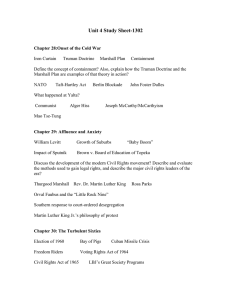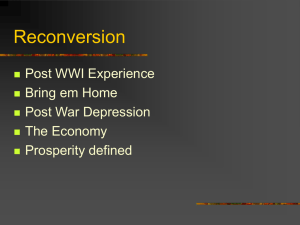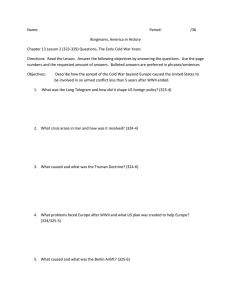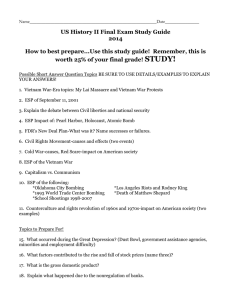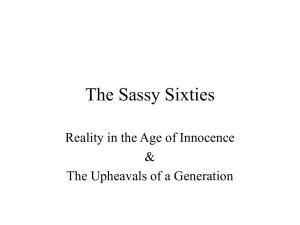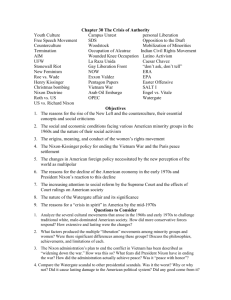Final Exam Review
advertisement
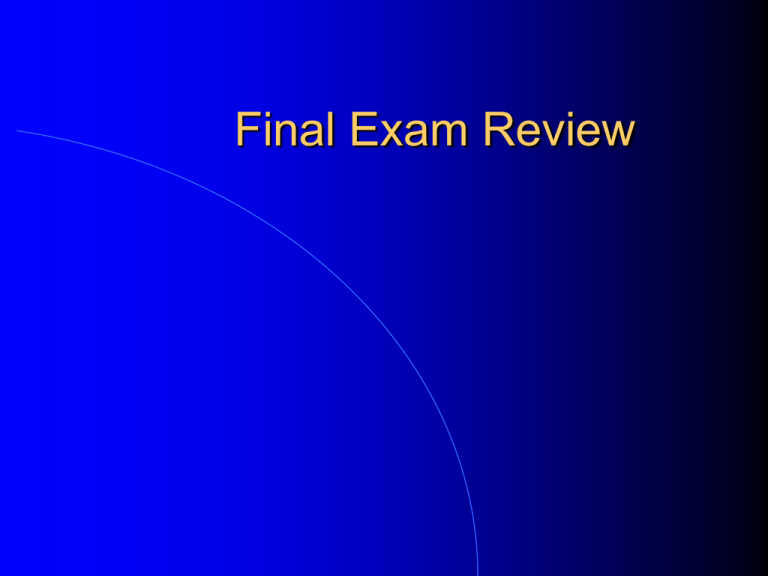
Final Exam Review 1. Suburbanization Movement from cities into the area around the cities known as suburbs Causes: – Increased Population in cities – Growing Middle Class – The rise of the automobile 2. Nativists White, United States-born, Protestant Hostile to immigrants Tried to restrict immigration to people who were not Anglo-Saxon 3. Scopes Trial Traditionalists believed in creationism and looked to outlaw teaching evolution in the classroom A high school teacher in Tennessee named John Scopes was convicted and fined $100 for teaching evolution in school Scopes Trial is all about evolution vs. creation 4. National Origins Act of 1924 A law that severely restricted immigration by installing quotas Discriminated against: – Eastern-Europeans – Japanese 5. The Harlem Renaissance An African American cultural revolution that started in Harlem, New York – A celebration of Black culture Literature, poetry, visual arts, music, etc. 6. Republican Presidents of the 1920’s Warren G. Harding Calvin Coolidge Herbert Hoover – All of these presidents emphasized the importance of business interests, and cared very little about social reform 7. Teapot Dome Scandal Illegal leasing of federal oil reserves by President Harding’s Secretary of the Interior to the Mammoth Oil Company – Gave cash gifts and no-interest loans in exchange for the land leases 8. Universal Negro Improvement Association Founded by Marcus Garvey Rejected integration in favor of Black Pride, economic self-sufficiency, and the formation of an independent black nation in Africa 9. Stock Market Crash 1929 One of the big factors that caused the Great Depression – Signaled the start of the Great Depression Known as Black Tuesday Some investors jumped out of windows By the time it was over, most companies were barely worth more than 10% of their former value 10. Failed Banks The other major cause of the Great Depression After the crash, there was a run on the banks as many Americans panicked Banks also lost money in the stock market crash, and did not have the money to give to the people There was no FDIC, so millions lost their savings 11. Hoover’s Response to the Depression Government should only intervene in business and labor conflicts if asked People should fend for themselves, and not rely on the government to bail them out Do-nothings 12. Neutrality Act of 1939 Allowed the sale of arms to belligerent nations on a “cash and carry basis” – Avoided giving aid to countries, and only if they transported the weapons Attempted to keep the United States neutral and out of war since we were in a depression – But did not completely show our neutrality, we weren’t exactly neutral 13. Lend Lease Acts The next step after “cash and carry” which allowed the United States to lend military equipment to Great Britain Britain needed help defending against the aggression of Germany – Ended US neutrality, but kept us out of war for the moment 14. Atlantic Charter 1941 Negotiated between Winston Churchill and FDR Established the vision of how the world would look like after WWII – End to imperialism, respect country’s borders, lower trade barriers It essentially provided the framework for America to get involved in WWII 15. Executive Order 9066 Presidential order from FDR that ordered the relocation of over 112,000 JapaneseAmericans living on the West Coast into internment camps – The US feared they were spies 16. Bracero Program There was a shortage of labor during WWII so the American and Mexican governments made a deal to allow Mexican citizens come to America and work for short periods of time – Usually contracts lasted 6-12 months – They were expected to return to Mexico when their contracts ended 17. Women During WWII Women were encouraged to work through the use of posters and other forms of propaganda They played vital roles in shipyards and in the aircraft industry Employment of women increased drastically during WWII because the men were overseas fighting 18. Manhattan Project Code name for the project to develop the atomic bomb Truman decided to drop the bomb on Japan because he believed that Japan would fight until the point of annihilation 19. The Big Three The big three who were at the Yalta Conference: – United States – Soviet Union – Great Britain 20. Yalta Conference Stalin, Churchill, and Roosevelt met in Crimea to discuss: – how they would finish the war – The future of the world after WWII Stalin agreed to allow Poland to have free elections, and that any new country to join the Soviet Union would also have free elections 21. Truman Doctrine President Truman’s policy of giving economic or military aid to any country threatened by communism or totalitarianism – An example is when the United States gave aid to Greece and Turkey to prevent them from falling into communism 22. Fair Deal Harry Truman’s economic package – All Americans should have health insurance – Increased minimum wage – Equal rights for all Americans 23. Marshall Plan The plan for European economic recovery after WWII – Planned to rebuild Europe and strengthen their economy 24. Containment United States plan during the Cold war to stop the Soviets from spreading communism 25. NATO North Atlantic Treaty Organization 10 Western European countries + United States and Canada signed a defense treaty 26. China and Communism China became communist (1946-1952) and caused the fear of communism to burn out of control in America Big defeat for containment 27. Warsaw Pact 1955 eight Eastern European nations signed a treaty with the Soviets in response to NATO – Defense Alliance 28. Dwight Eisenhower Eisenhower was able to be so successful politically because he was respected by both liberals and conservatives He was widely popular with the American people because he was a successful military general 29. Brinkmanship The willingness to go to the edge of war in order to keep peace – Included using atomic bombs 30. Domino Theory The idea that countries boarding communist countries were in danger of falling to communism as well – Think of dominoes lined up, once one falls they all fall one-by-one 31. Sputnik First satellite launched into space. Launched into space by the USSR Started the space race 32. Cuban Missile Crisis When Cuba fell to communism the Soviets allied with them and sent missiles to be set up in Cuba The United States saw this as a huge threat, because they could be hit from next door America put a blockade on the island, and forced the Soviets to back down – This event became the closest the world has ever come to full scale nuclear war 33. The Bay of Pigs The CIA trained Cuban exiles in 1961 to invade Cuba and overthrow the communist government This invasion failed 34. Operation Rolling Thunder 1965 – The first sustained bombing of North Vietnam – Ordered by President Johnson 35. Tonkin Gulf Resolution Granted President Johnson the power to use the military without a formal declaration of war on North Vietnam President now has broad military powers and an unprecedented of amount of power 36. Tet Offensive A massive offensive launched by the North Vietnamese on Tet – Vietnamese New Year 12 US bases and over 100 towns were attacked Its purpose was to trigger an uprising in South Vietnam and unite Vietnam against the Americans, but it resulted in a massive defeat for North Vietnam 37. Vietnamization President Nixon's plan to withdraw American troops from Vietnam – He wanted to make the Vietnam War a Vietnamese problem 38. Brown vs. Board of Education The Supreme Court ruling that declared segregation in public schools is unconstitutional 39. Montgomery Bus Boycott A NON-VIOLENT protest in response to racial segregation on buses in Montgomery, Alabama – Sparked by the Rosa Parks incident Protested by walking, using car pools, and through demonstrations – Note that these are all non-violent means 40. Lunch Counter Sit-Ins In 1960 four African American college students sat down at a Whites-only lunch counter to either be server or arrested – Non-violent method to protest segregation in places of business Started a trend and many more started doing it as well 41. Little Rock Nine In Little Rock, Arkansas 9 African American students were prevented from attending school After the governor ignored warnings from President Eisenhower, the national guard was sent in to protect the 9 Black students and escort them into the school 42. Freedom Riders They got onto buses in Washington D.C. and rode them into the Southern states to test if segregation had really been eliminated in the bus system These buses were attacked Challenged Segregation 43. March on Washington 1963 It turned civil rights from local to a national cause A biracial crowd of about 250,000 people assembled in front of the Lincoln Memorial Martin Luther King Jr. gave his most famous speech and was televised 44. Civil Rights Act of 1964 Outlawed segregation in all public accommodations – Any area that served the public 45. Black Power Celebrated African American heritage Stokely Carmichael and Malcolm X gave speeches trying to inspire Black pride Helped to unite and control Black communities through political activism 46. Black Panthers Founded by Bobby Seale and Huey Newton in Oakland, California 47. Watts Riots A six day riot in the Watts neighborhood in Los Angeles. Led to 34 deaths and over $40 million in property damage This event showed the world that racial unrest could result in violence 48. Counterculture Youth movement during the second half of the 1960s – They expressed their alienation from American society by sampling drugs and avoiding what was mainstream of the time – Peace sign became their symbol 49. The Feminine Mystique A book written by Betty Friedan that tried to show women that their lives were dull and unfulfilling Helped to spark the second feminine movement 50. Neil Armstrong The first man on the Moon. Apollo 11 mission 51. Watergate A scandal where men working for Nixon broke into the Watergate building, where the Democrat National Committee was being housed, and tried to plant bugs to spy on them Proved that the separation of powers could punish a President who became too powerhungry 52. President Nixon's Involvement in Watergate Nixon did not think he would win the election of 1972 – Sent in men to bug the Democrats in the Watergate building Took part in a cover-up plan once the burglars were caught After things looked bad for Nixon and he would be impeached, he resigned 53. The Nixon Tapes Revealed that Nixon had lied about his innocence in the Watergate cover-up – Proved to be his smoking gun 54. United Farm Workers Fought for the rights of farm workers Organized and led by Cesar Chavez 55. American Indian Movement (AIM) Started by a group in South Dakota Attempted to protect Native Americans from police brutality Aimed to increase economic opportunities for Native Americans 56. Kent State Massacre Four students were shot and killed at Kent state for protesting the American bombings in Cambodia 57. Roe vs. Wade Supreme court decision that ruled state laws could not prevent a woman from getting an abortion during the first 3 months of pregnancy Gave women the right to choose if they wanted to have a baby or not during the first trimester 58. The G.I. Bill Geared to help veterans in the areas of housing and education – Helped veterans find affordable housing and paid for their college 59. Levittown Mass-produced affordable homes in American suburbs – Based on the belief that every American should own a home 60. Baby Boom A trend from 1946-1950 where a significant increase in babies were being born Resulted from the end of WWII and men coming home from the war 61. Eisenhower's Political Image Eisenhower was able to be so successful politically because he was respected by both liberals and conservatives He was widely popular with the American people because he was a successful military general 62. Consumer Credit in the 50's During the 1950's consumers were more willing to buy things on credit Result from the economic boom 63. The Warren Commission and Kennedy Administration Investigated the assassination of President John F. Kennedy Determined it was Lee Harvey Oswald acting alone Left many loose-ends in its investigation – Some documents were destroyed or missing – Led to this event being very controversial 64. Economic Problems During the 70's Increased gas prices Rising energy costs High inflation Unemployment rate never peaked above 10% 65. Stagflation A combination of: – High inflation – High unemployment – Flat economy growth
